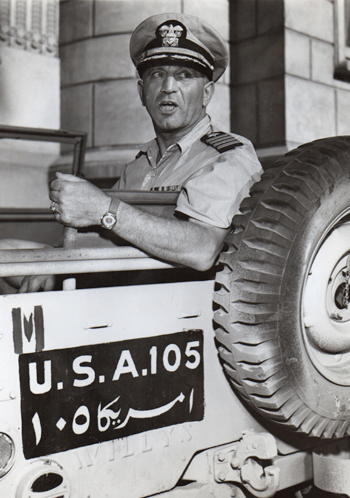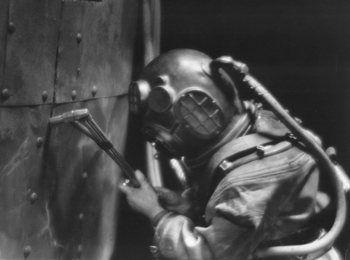The Salvage Admiral Retires to Maine
by Lee S. Wilbur

“COMMANDER CONTROL FORCE TO COMMANDING OFFICER U.S.S. Falcon: S-51 reported in collision latitude 41deg. 12Min N. longitude 71deg. 15Min. W. Falcon proceed to scene immediately prepared for rescue work.”
10:24PM, 25 September 1925, while operating from her base in New London Ct. in the vicinity of Block Island, United States submarine S-51was rammed and sunk by Boston bound steamship, “City of Rome.” Thirty-three officers and crewmen drowned. Three survived, City of Rome had failed to report the collision until some hours later as she neared the entrance to Cape Cod Canal.
Aboard Naval Salvage and Rescue vessel “Falcon,” Capt. Edward “Ned” Ellsberg received the message and within minutes Falcon was standing out of the New York Navy Yard and heading up the East River towards Long Island Sound. Thus began the harrowing saga of the raising of S-51 and her drowned crew under extremely trying conditions by a small, yet dedicated group of “hardhat” divers who would propel their young commander to naval fame. Lessons learned by Capt. Ellsberg and his inventions such as the underwater cutting torch, stabilized pontoons and a system to raise future sunken submarines from this salvage operation became milestones in world wide salvage; skills especially crucial during WWII.

Following the attack at Pearl Harbor in 1941 Ellsberg was posted to Massawa, Ethiopia, where he assumed command of all salvage operations in the African theatre.
For Ellsberg’s outstanding work and determination in raising the S-51, he became the first sailor to be awarded the Distinguished Service Medal in peacetime and by a special act of congress, promoted to Commander.
Born in Connecticut of Russian Jewish immigrants in 1891, he graduated from the U.S. Naval Academy (1914). Ned was not only first in his class, but garnered most of the graduation awards as well. Only once, for a show of temper in his senior year, did he receive demerits and even then was some 200 points ahead of his next highest ranked classmate at graduation. After being ordered to Massachusetts Institute of Technology for further training, he graduated with a Master’s Degree in Naval Architecture.
By 1927, Cdr. Ellsberg, remaining in the Naval reserve after entering civilian life, was called back on active duty to assist with the raising of submarine USS S-4, rammed and sunk by a Coast Guard cutter off Cape Cod. During the late 1920’s He had also begun a second career writing naval history as well as fiction beginning with “On the Bottom,” the riveting, detailed, first hand account of raising the S-51.
Mid-1934 found Ned and wife Lucy renting a cottage at the head of Southwest Harbor for the summer. It wasn’t long before realizing how much they truly enjoyed small town life on the coast of Maine. By 1938 they had built “The Anchorage,” a year round home on the Manset side of the harbor. Ned continued to write and did a great deal of contract work for Tidewater Oil Company. Then with the Japanese bombing of Pearl Harbor in 1941, he was on a train to Washington, D.C. and volunteering once again.
Ellsberg was called back
to assist with the raising
of submarine USS S-4,
sunk by a Coast Guard
cutter off Cape Cod.
Hoping to be sent to Pearl Harbor for salvage assistance, he was instead posted to Massawa, Ethiopa, where he assumed command of all salvage operations in the African theatre. There he was working in extremely difficult conditions with few trained divers and temperatures as high as 165 degrees. Within days of arrival Ellsberg and his crew began raising scuttled Italian and French ships which blocked the militarily important harbor. In just three months, the harbor facilities were working so well ships were being cleaned and basic overhauled in a record 24hrs. using the re-floated drydocks.
By June 19th, Ellsberg had been appointed by the President to the rank of Captain “for most outstanding service.” A promotion requested by none other than Dwight D. Eisenhower.......
Ellsberg, always a prolific letter writer, in a letter dated June 13, 1942, tells Lucy how he would love to have their “A” class sloop there in Massasawa “...with the whole Red Sea at my front door and Arab Dhows sailing all over the place.” In this same letter he expressed his concern about gas rationing for Lucy and daughter Mary when they go to Southwest Harbor for the season. Ned wrote “one way for you and Mary to get to Maine and still have a car there to drive, is to go by train and ship the station wagon the same way. You can make the telephone and Jackson’s (market) save you from having to use gasoline for groceries.”

Ellsberg operating what was at the time an experimental underwater cutting torch which he invented.
As World War II began to wind down in the Middle East, Ned was transferred to England where his salvage and marine experience could be better utilized. Reading “The Far Shore,” final book of his war experiences there, the opposite occurred. An open assignment to the British who would do things “their way or no way” left him quite frustrated, although as D-Day and the Normandy invasion unfolded he was finally able to give valuable assistance in the Mulberry Floating Harbor plans.
With the War’s end, Ned, now promoted to Rear Admiral, he and Lucy returned to their summer home which they soon sold, then bought another, “Windswept,” in 1950. Ned continued writing and consulting, as they enjoyed sailing “Argo” and life in a coastal Maine town.
In the late 50s, he was hired to develop a plan to raise the sunken “Andrea Doria” with dirigibles. Ned spent just one day on the job and declared it an “impossibility.”
I well remember “Admiral Ellsberg” in those days, seeming always to be wearing a floppy white tennis cap as he went about his errands and participated in town affairs. By 1956, He and Lucy had purchased a winter home in St. Petersburg, Florida. Ned died at age 92 from cancer, predeceased by his beloved daughter Mary and Lucy.
Fair Winds and Good Fishing
– Lee Wilbur
